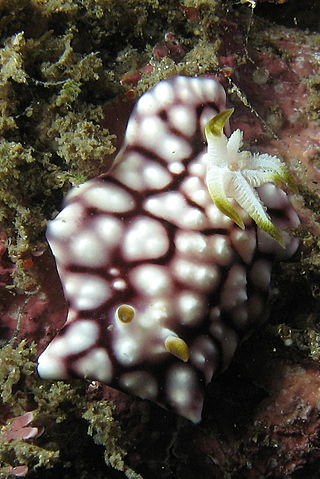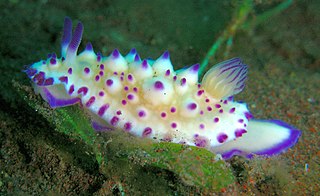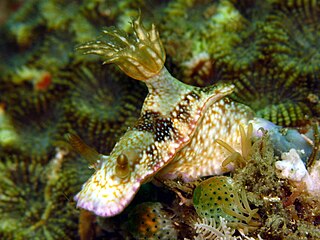
Chromodorididae, or chromodorids, are a taxonomic family of colourful sea slugs; dorid nudibranchs, marine gastropod mollusks in the superfamily Doridoidea. “Chromodorid nudibranchs are among the most gorgeously coloured of all animals.” The over 360 described species are primarily found in tropical and subtropical waters, as members of coral reef communities, specifically associated with their sponge prey. The chromodorids are the most speciose family of opisthobranchs. They range in size from <10mm to over 30 cm, although most species are approximately 15–30 mm in size.

Hypselodoris tryoni is a species of sea slug, a dorid nudibranch, a marine gastropod mollusk in the genus Chromodorididae.

Goniobranchus geometricus is a species of colourful sea slug, a dorid nudibranch, a marine gastropod mollusc in the family Chromodorididae.

Hypselodoris zephyra is a species of colourful sea slug or dorid nudibranch, a marine gastropod mollusk in the family Chromodorididae.

Doriprismatica atromarginata is a species of sea slug. It is a dorid nudibranch, a shell-less marine gastropod mollusk in the family Chromodorididae.

Mexichromis trilineata is a colourful species of sea slug, specifically a dorid nudibranch. This marine gastropod mollusc is in the family Chromodorididae. In 2012 the genus Pectenodoris was included into Mexichromis.

Durvilledoris was a genus of sea slugs, dorid nudibranchs, shell-less marine gastropod mollusks in the family Chromodorididae. This genus has become a synonym of Mexichromis Bertsch, 1977 Although the type species of this genus was transferred to Mexichromis two species were not reallocated nor mentioned in the text.

Mexichromis is a genus of colourful sea slugs, dorid nudibranchs, shell-less marine gastropod mollusks in the family Chromodorididae. Current synonymy follows a revision of Chromodorididae which used molecular phylogeny.

Verconia is a genus of sea slugs, dorid nudibranchs, shell-less marine gastropod mollusks in the family Chromodorididae.

Chromodoris michaeli is a species of colourful sea slug, a dorid nudibranch, a marine gastropod mollusk in the family Chromodorididae.

Hypselodoris maridadilus is a species of colourful sea slug or dorid nudibranch, a marine gastropod mollusk in the family Chromodorididae. It feeds on sponges.
Hypselodoris peasei is a species of sea slug or dorid nudibranch, a marine gastropod mollusk in the family Chromodorididae.

Hypselodoris iacula is a species of colourful sea slug or dorid nudibranch, a marine gastropod mollusk in the family Chromodorididae.

Hypselodoris reidi is a species of sea slug or dorid nudibranch, a marine gastropod mollusk in the family Chromodorididae.

Mexichromis pusilla is a species of sea slug or dorid nudibranch, a marine gastropod mollusk in the family Chromodorididae.
Mexichromis similaris is a species of sea slug or dorid nudibranch, a marine gastropod mollusk in the family Chromodorididae.
Mexichromis lemniscata is a species of colourful sea slug or dorid nudibranch, a marine gastropod mollusk in the family Chromodorididae.

Diversidoris crocea is a species of colourful sea slug, a dorid nudibranch, a shell-less marine gastropod mollusk in the family Chromodorididae.

Mexichromis katalexis is a species of sea slug, a dorid nudibranch, a shell-less marine gastropod mollusk in the family Chromodorididae.
Thorunna kahuna is a species of sea slug, a dorid nudibranch, a shell-less marine gastropod mollusk in the family Chromodorididae.














